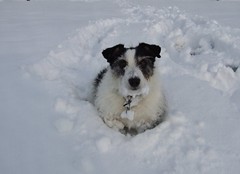
Every responsible pet owner should know the activities and whereabouts of their pet each day. However, sometimes our pets get mischievous and out of our sight for short periods of time. They may get into items that can do serious harm. Following a few safety tips can help keep your pet healthy and save you unnecessary anxiety, grief, and medical expense.
Medication
Keep all medication in a medicine cabinet and out of reach. Just as you would keep medicine away from a young child, the same applies for your pet. Even if you have medicine in child proof containers, it is possible for pets such as dogs or cats to get into these containers with their sharp teeth and strong jaws. Avoid leaving pills on a table or counter even if you are in the process of reaching for a glass of water to take your medication. Pets are quick to investigate and can have it eaten before you prevent them from doing so.
Small Household Objects
Whether you realize it or not, small objects can be very harmful to pets. Although some pets can swallow an object and later pass it through their feces, there are some objects that may get stuck in the stomach or intestines. If an object gets stuck in your pet, it can lead to health problems requiring surgery to remove. In rare cases, death could occur. To avoid a costly medical lesson, keep small objects out of reach from your pet.
Household Toxins
It is best to keep household items such as bleach, shampoo, bug sprays, and antifreeze locked up and out of reach from your pet. Any toxic substance can create a serious threat to your pet. If you plan to have your house sprayed for insects, make sure to ask that the exterminator use pet safe products whenever possible. If safe insecticide sprays cannot be used, remove your pet from the premises until it is safe for your pet to return to your home.
Human Food
Avoid feeding your pet human foods.
Although most dogs enjoy chewing on bones, chicken bones can cause choking for a pet if it gets hung in the throat. Chocolate is another food that can be dangerous to your dog’s health because a dog cannot digest chocolate.
Plants
Keep plants such as poinsettias away from your pet. Although poinsettias make an attractive decoration around the holidays, they are poisonous to eat. Sometimes dogs and cats are tempted to eat the leaves and suffer from an upset stomach or develop other health issues.
Mold and Your Pets
Black mold can develop in dark corners or cabinets within your home or outside buildings. Usually this type of mold can develop because of a flooding problem affecting the premises. Mold can cause many health problems in pets such as mild respiratory disease or sever lung problems. Mold poisoning can weaken the capillaries in the lungs of your pets which can cause bleeding. Hemorrhaging of the lungs can develop that can cause death. Make sure to have your home inspected periodically and have black mold problems eliminated through treatment. Other types of mold can grow on foods if left out for any length of time. Mold that grows on food can also be very harmful to your pet. Make sure to throw away any leftover food to avoid your pet from eating the leftovers and getting sick.
Because a pet is a part of your family that you grow to love, it is important to treat them as you would treat a young child. Always be careful to consider their mischievous personality and take the necessary preventative steps to ensure your pet’s safety at all times. By following these tips, your pet can live a long and happy life.
Featured images:
-  License: Creative Commons image source



